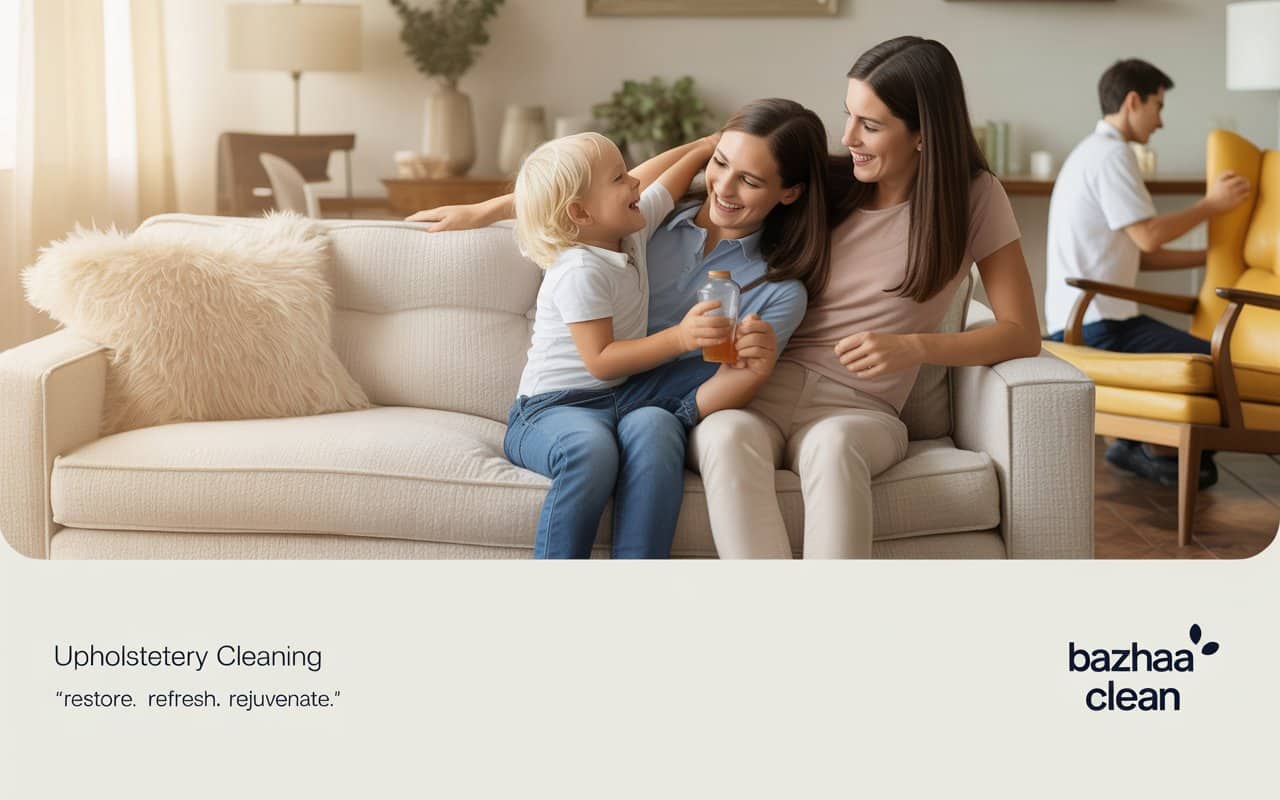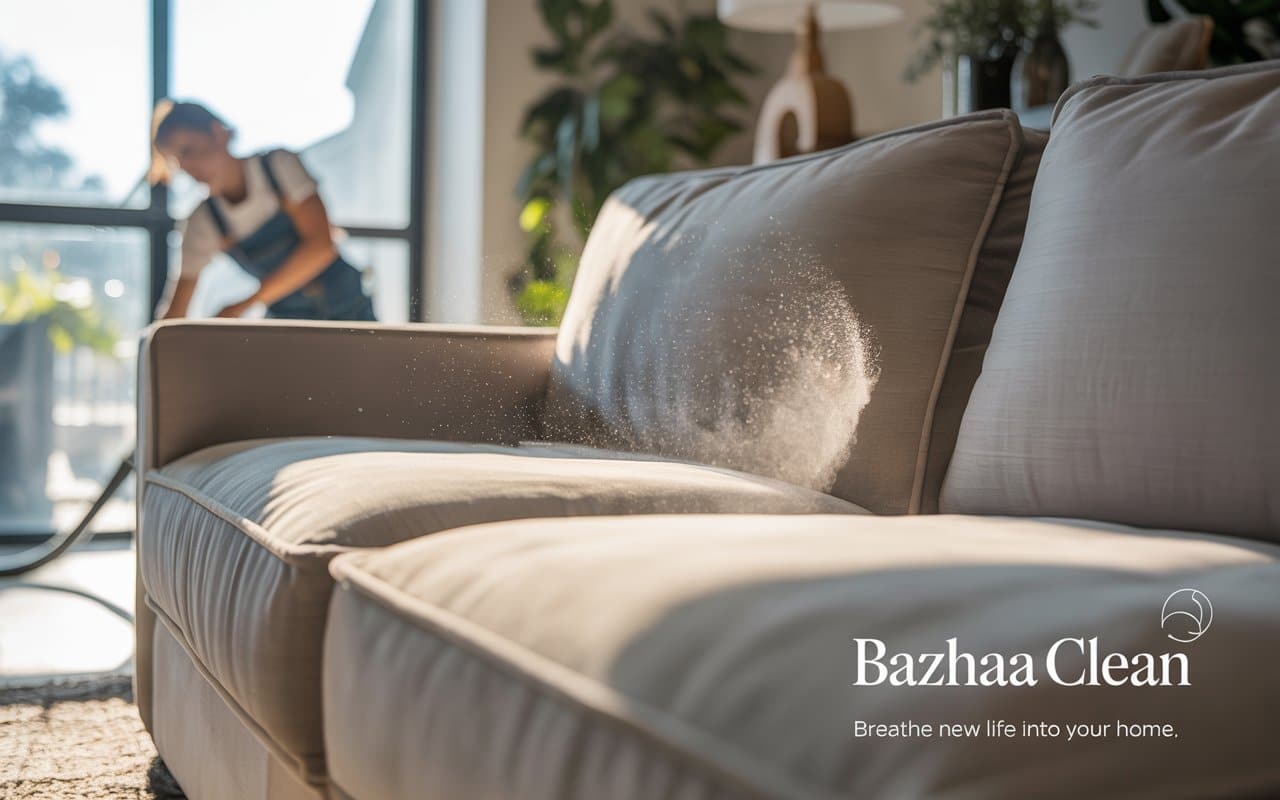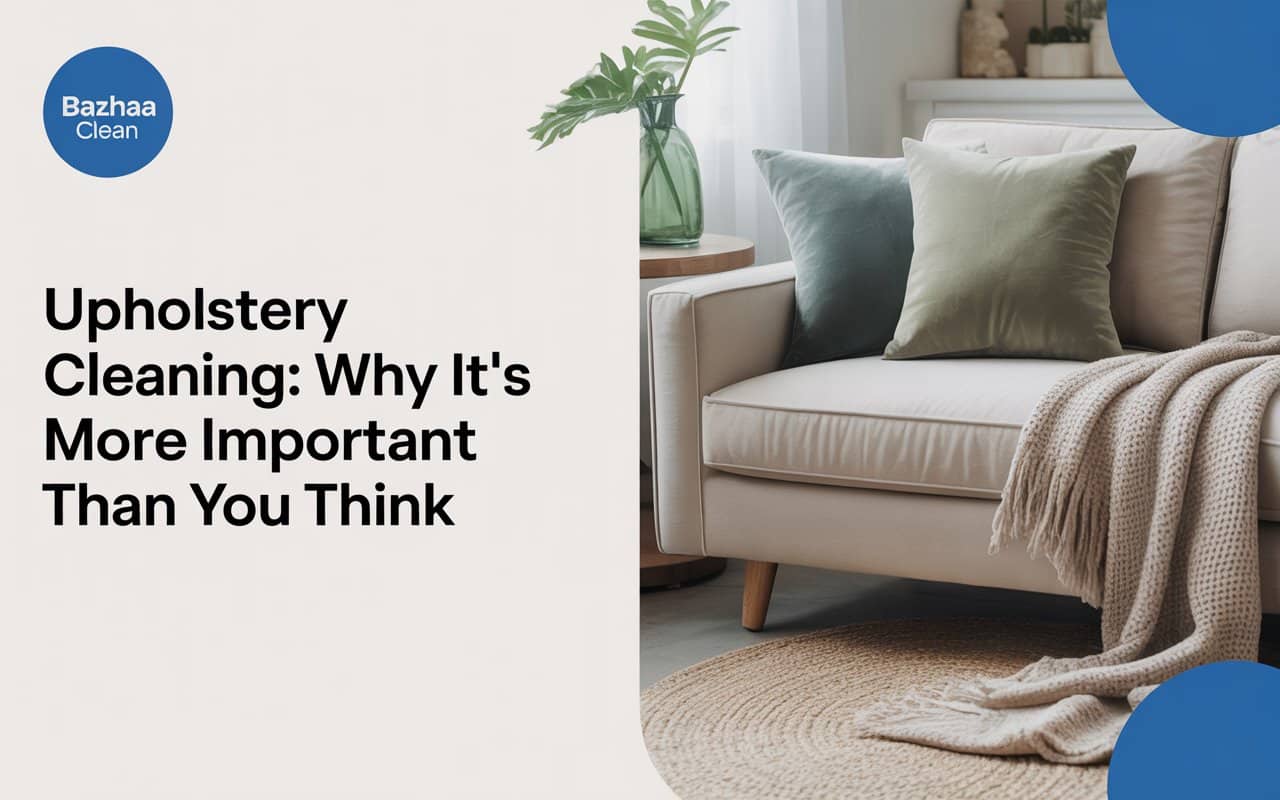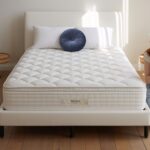Upholstery Cleaning: Why It’s More Important Than You Think
The Hidden World in Your Furniture
Let’s face it: furniture is the unsung hero of our homes. We crash on the couch after a long day, cuddle up with pets on the recliner, and guests plop down on our armchairs with zero hesitation. But have you ever wondered what’s actually lurking beneath the surface of your upholstery? It’s not just fabric and foam — it’s a jungle of dust, bacteria, body oils, food crumbs, allergens, pet hair, and in some cases, even mold spores. Over time, these particles embed themselves deep within the fibers and turn your once-cozy furniture into a hotspot for health hazards. Without proper care, that soft, comfy couch becomes a silent offender compromising your home’s hygiene and your family’s well-being.
Why We Often Overlook Upholstery Cleaning
Unlike obvious messes like dirty floors or stained countertops, the filth in your upholstery tends to stay hidden — until it starts to smell or look discolored. Because we rarely see the grime building up, it’s easy to assume everything is fine. Add to that the belief that vacuuming or a simple wipe-down is enough, and upholstery cleaning gets pushed further down our cleaning to-do list. The truth is, regular deep cleaning is not a luxury — it’s a necessity. Just like we maintain our cars and appliances, our furniture also needs some TLC to perform well and last longer.
What is Upholstery Cleaning?
Definition and Basics
Upholstery cleaning is a specialized process that involves the thorough cleaning of fabric-covered furniture such as sofas, chairs, cushions, and car seats. It’s not just about removing visible stains — it’s about penetrating deep into the fibers to eliminate accumulated dust, oils, allergens, and bacteria. Professional cleaners often use techniques like steam cleaning, hot water extraction, dry foam cleaning, or eco-friendly chemical treatments to rejuvenate the fabric and sanitize it completely. Whether it’s velvet, leather, suede, microfiber, or cotton, each type of material requires a unique approach to avoid damage and ensure optimal results.
Types of Upholstery That Need Regular Cleaning
Sofas
Sofas are the centerpiece of most living rooms. They get the most love — and abuse. From coffee spills and pet accidents to muddy shoes and popcorn crumbs during movie night, your sofa collects it all. Over time, this accumulation leads to dull fabric, lingering smells, and even allergies. Regular cleaning keeps it fresh and extends its life.
Armchairs
Whether it’s your reading spot or grandma’s favorite chair, armchairs often go unnoticed when it comes to cleaning. They too absorb body oils, sweat, and dirt, especially from consistent use. The armrests and headrests are common problem areas that tend to trap grime.
Mattresses
Though we cover them with sheets, mattresses still soak up sweat, skin flakes, and dust mites daily. Considering we spend a third of our lives sleeping, it’s alarming how little attention mattresses get. Regular deep cleaning can improve sleep quality and eliminate allergens.
Car Seats
Car upholstery faces constant abuse — think spilled drinks, crumbs, muddy shoes, pet fur, and even baby messes. Vacuuming helps, but it doesn’t sanitize. A proper clean not only refreshes your vehicle’s interior but also removes bacteria and smells.
Why Upholstery Cleaning is Often Ignored

The “Out of Sight, Out of Mind” Problem
What we don’t see, we tend to forget. Since most upholstery issues lie beneath the surface, homeowners don’t realize there’s a problem until it escalates. This mindset allows bacteria and allergens to build up silently, posing risks to both furniture and family.
Comparing to Carpet and Floor Cleaning
Floors get vacuumed regularly because they clearly show dust and dirt. Spills on carpets are obvious, and muddy footprints scream for attention. But upholstery? It rarely shows wear until it’s deeply embedded, making it an easy target for neglect.
Misconceptions About DIY Cleaning
Many believe a few sprays of air freshener or a dab of dish soap is enough to “clean” their furniture. However, DIY solutions often only address surface-level grime and can even cause fabric discoloration or shrinkage if used improperly. True upholstery cleaning requires professional-grade tools and training.
Health Benefits of Upholstery Cleaning
Eliminates Allergens and Dust Mites
Your couch may be a haven — for you and for microscopic creatures like dust mites. These tiny pests feed on dead skin cells and thrive in warm, moist environments like upholstered furniture. Over time, their waste can trigger allergies, skin irritation, and respiratory issues. Professional cleaning effectively eliminates these unwanted residents, making your home healthier.
Reduces Respiratory Issues
Poor indoor air quality is often linked to dirty furniture. Dust and allergens trapped in upholstery get released into the air every time someone sits down. For asthma sufferers and allergy-prone individuals, this can be a nightmare. Upholstery cleaning acts like a breath of fresh air — literally.
Prevents Mold and Bacteria Build-up
Accidental spills, pet accidents, and high humidity create a breeding ground for mold and bacteria in your furniture. Left untreated, these can cause skin rashes, musty odors, and even serious health problems. Deep cleaning neutralizes these threats before they take hold.
Protects Kids and Pets
Children and pets are the ones most often curled up on the couch, playing, eating, and even napping. Ensuring these surfaces are clean and germ-free minimizes their exposure to harmful pathogens and allergens.
Hygiene and Aesthetic Benefits
Odor Removal
A smelly couch is a deal-breaker for any living room. Whether it’s from sweat, food, pets, or mildew, bad odors seep into the fabric and linger. No amount of scented sprays can truly fix the issue. Professional cleaning removes the odor-causing particles, leaving your furniture smelling fresh and clean.
Restores Fabric Appearance
Over time, dust and grime cause upholstery to lose its shine and become dull. Regular cleaning revitalizes colors, smoothens fabric textures, and brings your furniture back to life. It’s like giving your couch a facial.
Maintains Color and Texture
Different fabrics react differently to dirt. Some fade, some harden, others become threadbare. Consistent cleaning preserves the original color and texture of the fabric, helping it maintain that showroom look.
Increases Furniture Lifespan
Protecting Fabric Integrity
Dirt acts like sandpaper — as people sit and move around on dirty upholstery, the embedded particles rub against the fibers, slowly wearing them down. Removing these particles protects the material and prevents premature wear and tear.
Saving Money in the Long Run
Furniture is a big investment. Replacing it frequently due to damage from neglect isn’t practical. Cleaning regularly helps you protect that investment, giving you many more years of use without spending extra money.
Professional vs DIY Upholstery Cleaning
Pros and Cons of DIY
DIY methods are affordable and convenient but risky. Using the wrong product or technique can cause irreversible damage. Many people accidentally shrink fabrics, fade colors, or leave behind water stains when trying to clean on their own.
Why Professionals Do It Better
Professionals are trained to handle different fabrics, identify the right treatments, and use powerful equipment that gets results. They can reach deep into the fibers and remove years of dirt in one session — something DIY just can’t achieve.
Tools and Techniques Used by Experts
From steam cleaners and high-suction vacuums to special pH-balanced detergents, pros use an arsenal of tools designed to clean effectively without damaging your furniture. Methods like hot water extraction, dry cleaning, or encapsulation cleaning are tailored to each type of fabric.
How Often Should Upholstery Be Cleaned?
General Guidelines
Experts recommend deep-cleaning your upholstery every 12–18 months. However, this depends on the usage and the type of household. For homes with kids, pets, or allergy sufferers, every 6–9 months may be more suitable.
High-Traffic Household Factors
If your living room doubles as a playroom, pet lounge, or Netflix corner, your furniture probably needs more attention. High-traffic homes experience faster dirt accumulation, meaning cleaning should be more frequent.
Upholstery Cleaning and Indoor Air Quality
The Airborne Pollutant Trap
Upholstered furniture acts like a filter for airborne particles. Over time, it traps pollen, smoke residue, dander, and more. When disturbed, those pollutants are released back into your breathing space, affecting air quality.
Upholstery as a Filter
Just like air purifiers need their filters cleaned, so does your furniture. By maintaining clean upholstery, you reduce the number of pollutants circulating through your home.
Signs Your Upholstery Needs Cleaning
Visual Cues
Notice your couch looking dull, stained, or greasy in some areas? That’s a red flag. So is uneven discoloration or dark patches in commonly used spots.
Unusual Smells
A lingering musty or sour odor means something is brewing inside your furniture — often bacteria or mold. Don’t ignore it.
Allergy Symptoms
If you notice sneezing, itchy eyes, or asthma flare-ups that mysteriously go away when you leave the house, your furniture may be to blame.
Eco-Friendly Upholstery Cleaning
Green Products and Techniques
More companies now offer environmentally friendly cleaning options using plant-based or biodegradable products. These methods are not only safer for the environment but also gentler on delicate fabrics and better for those with chemical sensitivities.
Sustainability Matters
Choosing eco-friendly services reduces waste and chemical runoff, helping you contribute to a healthier planet while maintaining a cleaner home.
Choosing the Right Upholstery Cleaning Service
What to Look for in a Cleaning Company
Choose companies with experience, proper certifications, and good reviews. Make sure they offer insurance and are transparent about their methods and prices.
Questions to Ask Before Hiring
-
Do you offer green cleaning options?
-
How do you handle delicate fabrics?
-
Can I see before-and-after results?
-
What is your guarantee or refund policy?
Upholstery Maintenance Tips Between Cleanings
Daily Care Habits
Avoid eating on upholstered furniture, keep pets off when possible, and use throws or covers to minimize direct contact.
Weekly Vacuuming
Use the upholstery brush attachment to remove loose dirt, pet hair, and crumbs before they settle in. Pay special attention to creases and seams.
Spot Cleaning Tricks
Blot spills immediately — never rub. Use cold water and mild soap for most fabrics, but always test on a hidden spot first. Avoid harsh chemicals that could damage or bleach the material.
Upholstery Cleaning for Businesses

Offices and Commercial Spaces
From office chairs and sofas in waiting rooms to restaurant booths and hotel lobbies, commercial furniture endures heavy use. Dirty upholstery creates a negative impression on clients and employees alike.
Customer Impressions Matter
First impressions are everything. Clean, well-maintained furniture sends a message of professionalism and care. On the other hand, dirty seating can drive customers away.
Cost of Upholstery Cleaning
Factors That Influence Pricing
The price depends on fabric type, stain severity, item size, location, and whether you choose steam or dry cleaning. Extra treatments like odor removal or anti-bacterial solutions may cost more.
Is It Worth the Investment?
Absolutely. Not only do you extend the life of your furniture, but you also improve your home’s hygiene and air quality. When you factor in the cost of potential replacements, cleaning is the smarter option.
Conclusion
Your upholstery isn’t just décor — it’s a living part of your home that sees daily use, absorbs your lifestyle, and quietly affects your environment. From health to aesthetics and even financial savings, the benefits of professional upholstery cleaning are enormous. So don’t wait until your sofa smells funky or looks patchy. Make upholstery care a regular part of your home maintenance, and your lungs, wallet, and furniture will all thank you.
FAQs
1. Can dirty upholstery really affect my health?
Yes, it can. Accumulated allergens, bacteria, and dust mites in upholstery can lead to respiratory problems, skin irritation, and worsen existing allergies.
2. How long does professional upholstery cleaning take?
It depends on the size and condition, but most jobs take 1–2 hours. Drying may take 4–6 hours afterward, depending on ventilation.
3. Is it safe to clean antique or delicate furniture?
Yes, but it must be done using specialized methods and experienced professionals who know how to handle fragile fabrics.
4. Will cleaning remove pet odors completely?
In most cases, yes. Professional cleaning targets the odor-causing bacteria deep in the fabric, not just the surface smell.
5. What’s the best way to maintain clean upholstery?
Regular vacuuming, using protective covers, immediate spot cleaning, and scheduling deep cleans every 6–12 months can keep your furniture in great shape.



